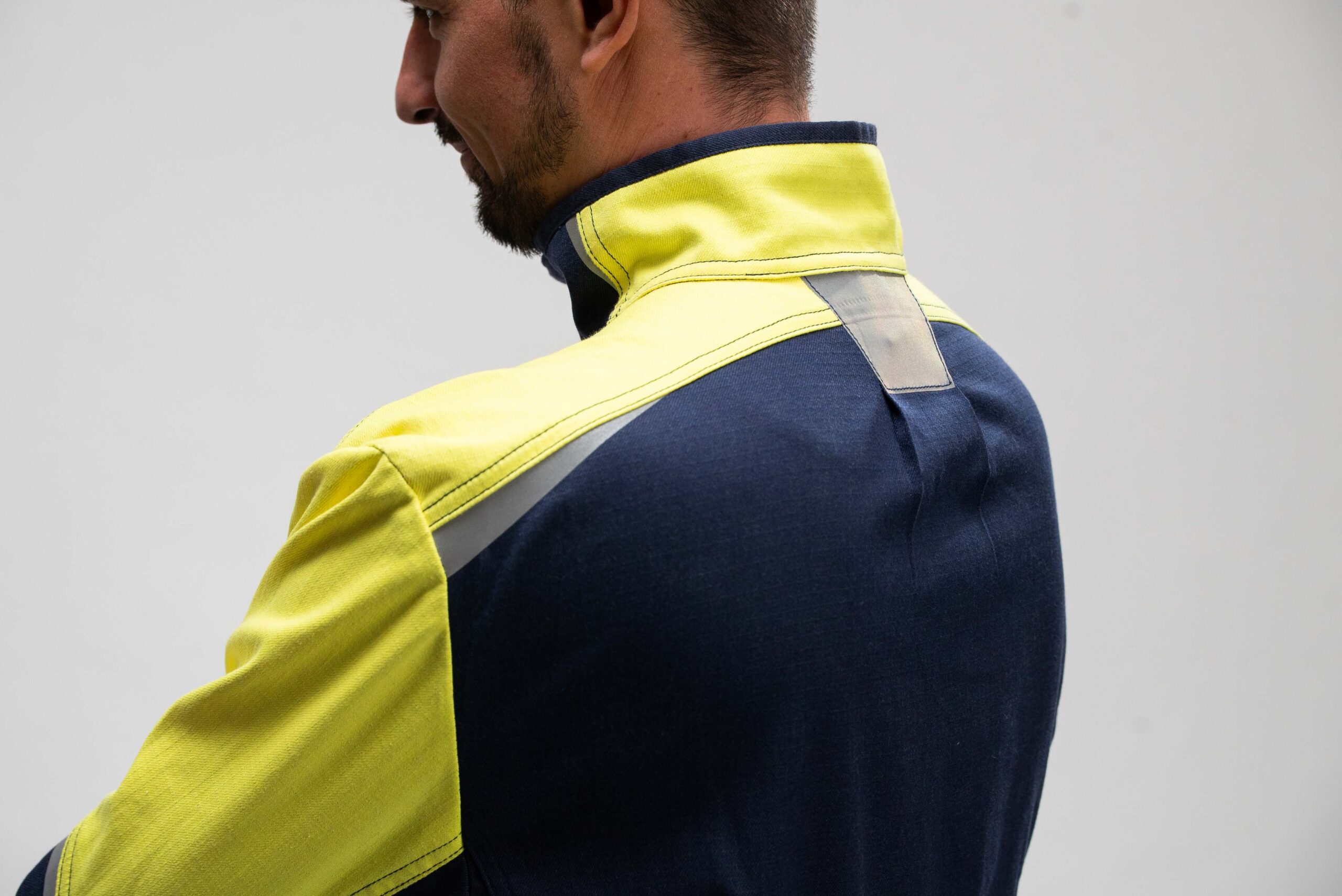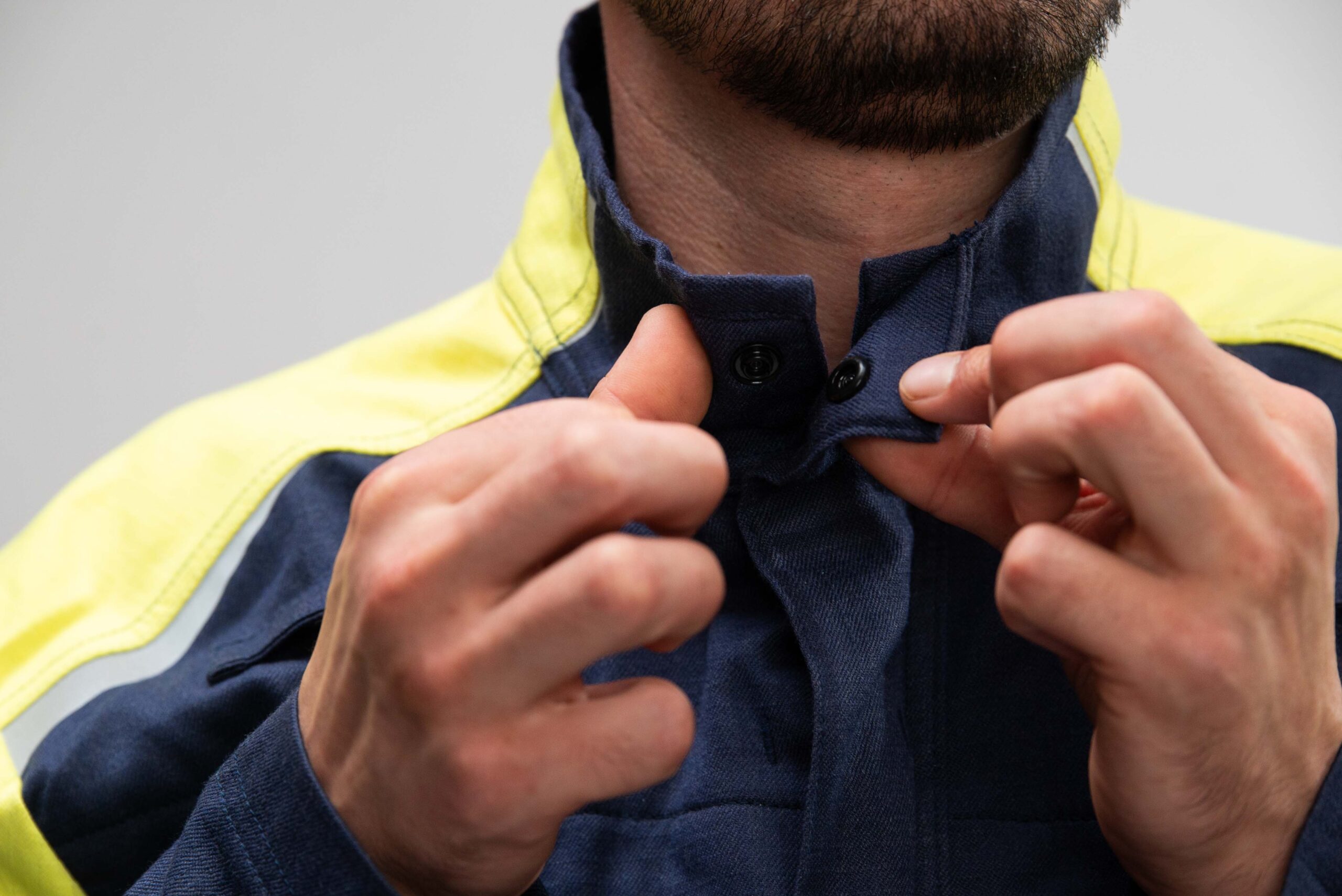What is flame-retardant workwear?
Flame-retardant workwear protects employees in industries where exposure to open fire, extreme heat, or sparks is a daily reality. This clothing is designed to delay the spread of flames and provide protection for workers.
Characteristics of flame-retardant clothing
These garments are made from materials that do not ignite immediately when exposed to fire. They can isolate the flame and slow down and extinguish its spread.
The primary feature of flame-retardant workwear is not that it is completely non-flammable, but that it extends the time to ignite and extinguishes flames within two seconds, allowing the wearer to escape to safety.
Types of flame-retardant materials
There are two main types of materials used for flame-retardant workwear:
Finished fabrics
These are fabrics treated with a chemical finish like Proban or Pyrovatex, giving the fabric flame-retardant properties. Generally less expensive, they are often used for protective clothing that offers protection against welding spatter and grinding windows.
Inherently flame-retardant fabrics
Materials such as Aramids (e.g., Nomex) and Modacryl have flame-retardant properties that do not diminish after repeated washing. These fabrics are more expensive but offer longer protection and are often stronger, making them suitable for less destructive but hazardous work environments like the chemical industry.
Differences between inherently flame-retardant fabrics: Aramids vs. Modacryl
To protect workers from fire and heat, various materials are used. Aramids and Modacryl are both popular choices for flame-retardant workwear.
They have distinct properties that make them suitable for specific applications. Here, the main differences between them are highlighted.
Aramids
Aramids, such as Nomex and Conex, are inherently flame-retardant materials particularly suited for less destructive tasks, like those in the chemical industry. The main benefits of aramids include:
- Protection against liquid chemicals: Aramids, treated with a fluorocarbon, offer excellent protection against various chemicals. They are also hydrophobic, meaning they do not absorb water and other liquids.
- Durability: Aramids wear slowly and are highly durable, which gives them a longer lifespan. The higher initial costs are offset by this durability.
Modacryl
Modacryl is another type of inherently flame-retardant material, often less expensive than aramids but more costly than finished materials. Modacryl is versatile in use:
- Versatile applications: Modacryl can be used for both light welding and grinding work as well as for tasks that aramids also perform. This makes Modacryl a flexible choice for companies needing protection against both fire and chemical risks.
- Chemical protection: When combined with a fluorocarbon finish, Modacryl also offers considerable protection against chemical splashes. This finish adheres well to the synthetic fibers of composite Modacryl fabrics, enhancing protection against liquid chemical splashes.
Antistatic Properties
Both materials can be equipped with antistatic properties by adding an antistatic fiber, typically a carbon fiber. This is crucial in environments where electrical discharge could pose a risk, such as in explosion-prone (ATEX) zones.Bovenkant formulierOnderkant formulier
Conclusion
Choosing the right flame-retardant workwear is crucial for safety in hazardous environments. Each material offers advantages depending on the specific requirements of the work environment. Durability, chemical resistance, and antistatic properties are key factors. By carefully weighing these properties, a company can create a safe working environment that ensures the protection of its employees.
FAQ
- What is the main advantage of flame-retardant workwear?
Flame-retardant workwear is designed to delay the spread of flames, giving workers extra time to reach safety when exposed to fire, extreme heat, or sparks. - What is the difference between finished and inherently flame-retardant fabrics?
Finished fabrics are treated with chemical finishes like Proban or Pyrovatex to be flame-retardant, but their protective properties can diminish over time and with washes. Inherently flame-retardant fabrics like Aramids and Modacryl retain their flame-retardant properties permanently, even after frequent washing. - Which types of flame-retardant workwear are most suitable for the chemical industry?
For the chemical industry, Aramids such as Nomex and Conex are recommended because of their durability and hydrophobic properties that help repel liquid chemicals. - How often should flame-retardant workwear be replaced?
The replacement frequency of flame-retardant workwear depends on the type of material and the intensity of exposure to risks. As soon as damage occurs in the fabric, the garment should be replaced. - Are there flame-retardant materials that also provide protection against electrical discharge?
Yes, both finished and inherently flame-retardant fabrics can be equipped with antistatic properties by adding an antistatic fiber, such as carbon fiber, to ensure safety in explosion-prone (ATEX) zones.




 België / Belgique
België / Belgique Français
Français
 English
English
 The Netherlands
The Netherlands Deutschland
Deutschland International
International
